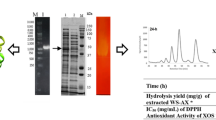Abstract
In this study, we report the first functional cloning and heterogeneous expression of 3-ketovalidoxylamine C-N lyase (E.C. 4.3.3.1) from Flavobacterium saccharophilum IFO 13984. This gene is 1,098 bp in length and encodes a peptide of 366 amino acids. The recombinant C-N lyase was successfully overexpressed in E. coli, and its functional activity, degradation of 3-ketovalidoxylamine A, was confirmed by HPLC analysis. The sequence and phylogenetic analysis showed that the C-N lyase has no similarity with other amine lyases (E.C. 4.3.3) but has similarity with the conserved domain present in SusD and RagB. Thus, the C-N lyase may have a similar binding domain for sugar moieties with SusD/RagB. This genetic information may lead to improvements in C-N lyase function for industrial applications.
Similar content being viewed by others
References
Kameda, Y. and S. Horii (1972) The unsaturated cyclitol part of the new antibiotics, the validamycins. J. Chem. Soc. Chem. Commun. 12: 746–747.
Kameda, Y., S. Horii, and T. Yamano (1975) Microbial transformation of validamycins. J. Antibiot. 28: 298–306.
Zheng, Y. G., X. F. Zhang, and Y. C. Shen (2005) Microbial transformation of validamycin A to valienamine by immobilized cells. Biocatal. Biotransform. 23: 71–77.
Kameda, Y., N. Asano, and M. Teranishi (1981) New intermediates, degradation of validamycin A by Flavobacterium saccharophilum. J. Antibiot. 34: 1237–1240.
Kameda, Y., N. Asano, M. Teranishi, and K. Matsui (1980) New cyclitols, degradation of validamycin A by Flavobacterium saccharophilum. J. Antibiot. 33: 1573–1574.
Zheng, Y. G., Y. P. Xue, and Y. C. Shen (2006) Production of valienamine by a newly isolated strain: Stenotrophomonas maltrophilia. Enz. Microb. Technol. 39: 1060–1065.
Asano, N., M. Takeuchi, and K. Ninomiya (1984) Microbial degradation of validamycin A by Flavobacterium saccharophilum. Enzymatic cleavage of C-N linkage in validoxylamine A. J. Antibiot. 37: 859–867.
Fukase, H. (1997) Development of voglibose (Basen®), an antidiabetic agent. J. Synth. Org. Chem. 55: 920–925.
Yin, Y., W. Huang, and D. Chen (2007) Preparation of validoxylamine A by biotransformation of validamycin A using resting cells of a recombinant Escherichia coli. Biotechnol. Lett. 29: 285–290.
Zhang, J. F., Y. G. Zheng, Y. P. Xue, and Y. C. Shen (2006) Purification and characterization of the glucoside 3-dehydrogenase produced by a newly isolated Stenotrophomonas maltrophilia CCTCC M 204024. Appl. Microbiol. Biotechnol. 71: 638–645.
Takeuchi, M., N. Asano, Y. Kameda, and K. Matsui (1985) Purification and properties of 3-ketovalidoxylamine A C-N lyase from Flavobacterium saccharophilum. J. Biochem. 98: 1631–1638.
Takeuchi, M., N. Asano, Y. Kameda, and K. Matsui (1986) Chemical modification by diethylpyrocarbonate of an essential histidine residue in 3-ketovalidoxylamine A C-N lyase. J. Biochem. 99: 1571–1577.
Takeuchi, M., N. Asano, Y. Kameda, and K. Matsui (1988) Fluorometric studies on the role of calcium in substrate binding to 3-ketovalidoxylamine A C-N lyase. Chem. Pharm. Bull. 36: 3540–3545.
Takeuchi, M., K. I. Neyazaki, and K. Matsui (1990) Chemical modification by 2,4,6-trinitrobenzenesulfonic acid (TNBS) of an essential amino group in 3-ketovalidoxylamine A C-N lyase. Chem. Pharm. Bull. 38: 1419–1420.
Saito, H. and K. I. Miura (1963) Preparation of transforming deoxyribonucleic acid by phenol treatment. Biochim. Biophys. Acta 72: 619–629.
Cokesa, Z., H. J. Knackmuss, and P. G. Rieger (2004) Biodegradation of all stereoisomers of the EDTA substitute iminodisuccinate by Agrobacterium tumefaciens BY6 requires an epimerase and a stereoselective C-N lyase. Appl. Env. Microbiol. 70: 3941–3947.
Negri, A., V. Massey, and C. H. Williams Jr (1987) D-aspartate oxidase from beef kidney. Purification and properties. J. Biol. Chem. 262: 10026–10034.
Szwajcer, E. and K. Mosbach (1985) Isolation and partial characterization of a D-amino acid oxidase active against cephalosporin C from the yeast Trigonopsis variabilis. Biotechnol. Lett. 7: 1–7.
Bradford, M. M. (1976) A rapid and sensitive method for the quantitation of microgram quantities of protein utilizing the principle of protein dye binding. Anal. Biochem. 72: 248–254.
Laemmli, U. K. (1970) Cleavage of structural proteins during the assembly of the head of bacteriophage T4. Nature 227: 680–685.
Kawano, C., H. Katsuki, T. Yoshida, and S. Tanaka (1962) A method for extraction and determination of 2,4-dinitrophenylhydrazones of keto acids. Anal. Biochem. 3: 361–368.
Bendtsen, J. D., H. Nielsen, G. Von Heijne, and S. Brunak (2004) Improved prediction of signal peptides: SignalP 3.0. J. Mol. Biol. 340: 783–795.
Koropatkin, N. M., E. C. Martens, J. I. Gordon, and T. J. Smith (2008) Starch catabolism by a prominent human gut symbiont is directed by the recognition of amylose helices. Structure 16: 1105–1115.
Koropatkin, N. M. and T. J. Smith (2010) SusG: A unique cellmembrane-associated α-Amylase from a prominent human gut symbiont targets complex starch molecules. Structure 18: 200–215.
Wang, Y. S., Y. G. Zheng, and Y. C. Shen (2007) Isolation and identification of a novel valienamine-producing bacterium. J. Appl. Microbiol. 102: 838–844.
Tamura, K., J. Dudley, M. Nei, and S. Kumar (2007) MEGA4: Molecular evolutionary genetics analysis (MEGA) software version 4.0. Mol. Biol. Evolution 24: 1596–1599.
Author information
Authors and Affiliations
Corresponding author
Rights and permissions
About this article
Cite this article
Kim, J.G., Joo, J.C., Kim, S.K. et al. Gene cloning and expression of a 3-ketovalidoxylamine C-N-lyase from Flavobacterium saccharophilum IFO 13984. Biotechnol Bioproc E 16, 366–373 (2011). https://doi.org/10.1007/s12257-010-0255-0
Received:
Revised:
Accepted:
Published:
Issue Date:
DOI: https://doi.org/10.1007/s12257-010-0255-0




